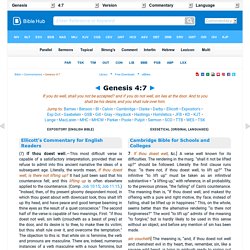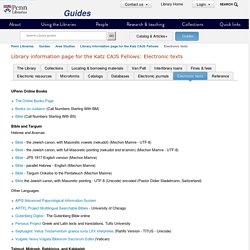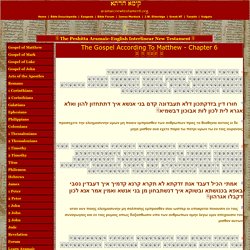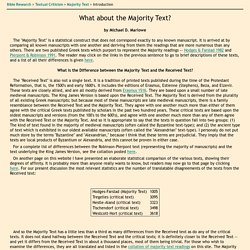

Twitter. - Checking translations of Holy Scripture. It's important to know where a translation of scripture might be untrustworthy or obscure the meaning of the original Greek texts.

Absent working directly from a Nestle-Aland, you'll want to check certain texts against the Greek. Here's some specific verses I've found helpful for understanding where the biases in a particular translation might be. Translations So then, brethren, stand firm and hold to the traditions which you were taught by us, either by word of mouth or by letter. Therefore, brothers, stand firm and hold fast to the traditions that you were taught, either by an oral statement or by a letter of ours. Therefore, brethren, stand fast, and hold the traditions which ye have been taught, whether by word, or our epistle. So then, brothers and sisters, stand firm and hold fast to the teachings we passed on to you, whether by word of mouth or by letter. Vulgate itaque fratres state et tenete traditiones quas didicistis sive per sermonem sive per epistulam nostram. Genesis 4:7 Commentaries: "If you do well, will not your countenance be lifted up? And if you do not do well, sin is crouching at the door; and its desire is for you, but you must master it."
—This most difficult verse is capable of a satisfactory interpretation, provided that we refuse to admit into this ancient narrative the ideas of a subsequent age.

Literally, the words mean, is often elsewhere applied to the countenance. About the Online-Bibles. Twitter. Isaac T. Soon sur Twitter : "A short thread about “dogs” in Phil 3:2 and their domestication. In this well-known passage, Paul warns the Philippians about a certain group of people whom he labels with the epithets “dogs”, “the slashing,” and “evil workers. Interesting...The resurrection really happened: textual criticism and Easter — Southern Equip. Eva Mroczek sur Twitter : "Why were the gospels written at all? Great new book by @chriskeith7 is out for some quarantine reading. Congratulations to Chris - not only a model scholar, but a pretty great human being too. Read his book!…
2)... punishment of a known sinner—is traceable to the Historical Jesus, and thus a first-century investigative background would seem proper.“ Photo source. Dr. Sarah Bond sur Twitter : "February 8, 553: The emperor Justinian rules (De Hebraeis, Novel 146) that the Jewish people now be allowed to read the Hebrew Bible in Greek––or other languages. The Torah could be read in Greek, preferably the Septuagint & Textual Encounters – A Blog about Scholarship on Early Christianity and Ancient Judaism. Are Same-Sex Relations Condemned in the Old Testament? – The Bart Ehrman Blog. When people want to show that the Bible condemns same-sex relations – either to justify depriving LGBTQ people of civil rights, to condemn them morally, to preclude them from serving in church offices, or even to participate at all in faith communities (or for any other reason) – there are a few passages that typically get cited, usually with vigor.

This article and digital project are so simultaneously 2019 and 1215 CE, I can’t even believe it. Exodus 3:14 in Early Jewish and Christian Translations. Scaife Viewer. Electronic texts - Library information page for the Katz CAJS Fellows - Guides at Penn Libraries. UPenn Online Books The Online Books Page Books on Judaism (Call Numbers Starting With BM) Bible (Call Numbers Starting With BS) Bible and Targum Hebrew and Aramaic.

Peshitta Aramaic-English New Testament Interlinear Bible - Matthew 6. 1 ܚܽܘܪܘ ܕ݁ܶܝܢ ܒ݁ܙܶܕ݂ܩܰܬ݂ܟ݂ܽܘܢ ܕ݁ܠܳܐ ܬ݁ܶܥܒ݁ܕ݂ܽܘܢܳܗ ܩܕ݂ܳܡ ܒ݁ܢܰܝ ܐ݈ܢܳܫܳܐ ܐܰܝܟ݂ ܕ݁ܬ݂ܶܬ݂ܚܙܽܘܢ ܠܗܽܘܢ ܘܶܐܠܳܐ ܐܰܓ݂ܪܳܐ ܠܰܝܬ݁ ܠܟ݂ܽܘܢ ܠܘܳܬ݂ ܐܰܒ݂ܽܘܟ݂ܽܘܢ ܕ݁ܒ݂ܰܫܡܰܝܳܐ܂ 1 חורו דין בזדקתכון דלא תעבדונה קדם בני אנשא איך דתתחזון להון ואלא אגרא לית לכון לות אבוכון דבשמיא܂ 1 προσεχετε την ελεημοσυνην υμων μη ποιειν εμπροσθεν των ανθρωπων προς το θεαθηναι αυτοις ει δε μηγε μισθον ουκ εχετε παρα τω πατρι υμων τω εν τοις ουρανοις 2 ܐܶܡܰܬ݂ܝ ܗܳܟ݂ܺܝܠ ܕ݁ܥܳܒ݂ܶܕ݂ ܐܰܢ݈ܬ݁ ܙܶܕ݂ܩܬ݂ܳܐ ܠܳܐ ܬ݁ܶܩܪܶܐ ܩܰܪܢܳܐ ܩܕ݂ܳܡܰܝܟ݁ ܐܰܝܟ݂ ܕ݁ܥܳܒ݂ܕ݁ܺܝܢ ܢܳܣܒ݁ܰܝ ܒ݁ܰܐܦ݁ܶܐ ܒ݁ܰܟ݂ܢܽܘܫܳܬ݂ܳܐ ܘܰܒ݂ܫܽܘܩܶܐ ܐܰܝܟ݂ ܕ݁ܢܶܫܬ݁ܰܒ݁ܚܽܘܢ ܡܶܢ ܒ݁ܢܰܝ ܐ݈ܢܳܫܳܐ ܘܰܐܡܺܝܢ ܐܳܡܰܪ ܐ݈ܢܳܐ ܠܟ݂ܽܘܢ ܕ݁ܩܰܒ݁ܶܠܘ ܐܰܓ݂ܪܗܽܘܢ܂ 2 אמתי הכיל דעבד אנת זדקתא לא תקרא קרנא קדמיך איך דעבדין נסבי באפא בכנושתא ובשוקא איך דנשתבחון מן בני אנשא ואמין אמר אנא לכון דקבלו אגרהון܂

Peshitta. The Peshitta (Classical Syriac: ܦܫܝܛܬܐ pšîṭtâ) is the standard version of the Bible for churches in the Syriac tradition.

Etymology[edit] The name 'Peshitta' is derived from the Syriac mappaqtâ pšîṭtâ (ܡܦܩܬܐ ܦܫܝܛܬܐ), literally meaning 'simple version'. However, it is also possible to translate pšîṭtâ as 'common' (that is, for all people), or 'straight', as well as the usual translation as 'simple'. Syriac is a dialect, or group of dialects, of Eastern Aramaic, originating around Edessa. Why does Jesus say, “Amen, Amen, I tell you”? In most recent English translations of the Gospels Jesus frequently says, “Truly I say to you” or “I tell you the truth.”

This conveys a clear meaning, but the problem is that in the Greek text Jesus, in the great majority of cases, does not use the Greek word for “truly” [ἀληθῶς / alethos] or “truth [ἀλήθεια / aletheia].” Even though his conversation is being reported in Greek, Jesus consistently is quoted as using the Hebrew word Amen. The Didache: A Missing Piece of the Puzzle in Early Christianity - Biblical Archaeology Society. The Didache: A Missing Piece of the Puzzle in Early Christianity Early Christianity and Its Literature 14 Edited by Jonathan A.

Draper and Clayton N. Jefford (Atlanta: Society of Biblical Literature Press, 2015), 631 pp., $75.95 (softcover), $95.95 (hardcover) Reviewed by Tony Burke. Aramaic alphabet - Wikipedia. Semitic script native to Greater Syria The ancient Aramaic alphabet was adapted from the Phoenician alphabet and became a distinct script by the 8th century BC.

It was used to write the Aramaic language and had displaced the Paleo-Hebrew alphabet, itself a derivative of the Phoenician alphabet, for the writing of Hebrew. The letters all represent consonants, some of which are also used as matres lectionis to indicate long vowels. The Aramaic alphabet is historically significant since virtually all modern Middle Eastern writing systems can be traced back to it as well as numerous non-Chinese writing systems of Central and East Asia. Peshitta Aramaic/English Interlinear New Testament. The Murderous History of Bible Translations: Power, Conflict and the Quest ... - Harry Freedman. What about the Majority Text? By Michael D.

Marlowe The "Majority Text" is a statistical construct that does not correspond exactly to any known manuscript. It is arrived at by comparing all known manuscripts with one another and deriving from them the readings that are more numerous than any others. There are two published Greek texts which purport to represent the Majority readings -- Hodges & Farstad 1982 and Pierpont & Robinson 1991. The reader may click on the links in the previous sentence to go to brief descriptions of these texts, and a list of all their differences is given here. Greek New Testament - New Internet Edition With Critical Apparatus (Editio Internet Critica Maior) Encyclopedia of New Testament Textual Criticism.
A Site Inspired By Conceived by Rich Elliott of Simon Greenleaf Universityreelliott@verizon.net The Encyclopedia attempts to cover all aspects of New Testament Textual Criticism in an orderly and fair fashion. NT Manuscripts - Papyri. Contents: * P11 * P13 * P20 * P24 * P28 * P39 * P45 * P46 * P48 * P51 * P52 * P54 * P74 * P75 * P78 * P90 * Note: Many of the papyri, especially the Beatty and Bodmer papyri, have been subject to so much discussion that no attempt is made to compile a full bibliography. Location/Catalog Number Saint Petersburg, Russian National Library Gr. 258A Contents 1 Corinthians 1:17-22, 2:9-12, 2:14, 3:1-3, 3:5-6, 4:3-5:5, 5:7-8, 6:5-9, 6:11-18, 7:3-6, 7:10-14, with even the surviving verses often damaged (so much so that Tischendorf was unable to tell whether the fragments he had were of five or six leaves). Date/Scribe Dated paleographically to the seventh century.
Description and Text-type. The Majority Text and the Original Text: Are They Identical? Editor's Note:1 In recent years a small but growing number of New Testament scholars have been promoting what appears to be a return to the Textus Receptus, the Greek text that stands behind the New Testament of the King James Version. King David. Portal:New Testament Greek - Wikiversity. Welcome! Textual criticism of the New Testament - Wikipedia. A folio from Papyrus 46, one of the oldest extant New Testament manuscripts The textual criticism of the New Testament is the analysis of the manuscripts of the New Testament, whose goals include identification of transcription errors, analysis of versions, and attempts to reconstruct the original. The New Testament has been preserved in more than 5,800 Greek manuscripts, 10,000 Latin manuscripts and 9,300 manuscripts in various other ancient languages including Syriac, Slavic, Ethiopic and Armenian.
There are approximately 300,000 textual variants among the manuscripts, most of them being the changes of word order and other comparative trivialities.[1][2] Nonetheless, these manuscripts are copies of copies of copies and maintain a 99.5% accuracy to each other. This fact is unprecedented in light of other ancient texts. Alexandrian text versus Byzantine text[edit] Textual variants in the New Testament - Wikipedia. Textual variants in the New Testament are the subject of the study called textual criticism of the New Testament. Textual variants in manuscripts arise when a copyist makes deliberate or inadvertent alterations to a text that is being reproduced.
Most of the variations are not significant and some common alterations include the deletion, rearrangement, repetition, or replacement of one or more words when the copyist's eye returns to a similar word in the wrong location of the original text. If their eye skips to an earlier word, they may create a repetition (error of dittography). If their eye skips to a later word, they may create an omission resort to performing a slight rearranging of words to retain the overall meaning without compromising the context.
In other instances, the copyist may add text from memory from a similar or parallel text in another location. Genesis 1 Interlinear Bible. Author, Professor, Religious Scholar. How_the_Bible_Became_a_Book.pdf. Handel's Messiah. Codex Sinaiticus - Home. Greek and Hebrew Reader's Edition. Matthew. English Scripture Passages from "The 1901 American Standard Version" The 1901 American Standard Version Bible (ASV) is in the public domain, and may be freely copied. Online Hebrew Interlinear Bible. The Ancient Hebrew Alphabet - Lesson 13. Go to Lesson #...Introduction Learn to Read Biblical Hebrew - Lesson 13 Hebrew Verbs By: Jeff A.
Benner Learn Hebrew Verbs - Introduction. Introduction to Hebrew Verbs. Academy of Ancient Languages. The audio tracks below in mp3 format are courtesy of Audio Scriptures International. I have used audio editing software to divide the book files from ASI into separate chapter files. Please report broken links or any other problems to me via email. Hebrew - English Bible by Books / Mechon-Mamre. Here are direct links to recordings in Hebrew, used with permission from Talking Bibles International ℗ 1992 (to request permission to use recordings write info@talkingbibles.org); they are not chanted with a melody, but are clearly pronounced in Sephardic-style Hebrew. Some of these chapter files are large (up to almost 8MB!) , so those without fast internet connections really need patience in waiting for them.
LATIN PRAYERS. M.academic-bible.com.